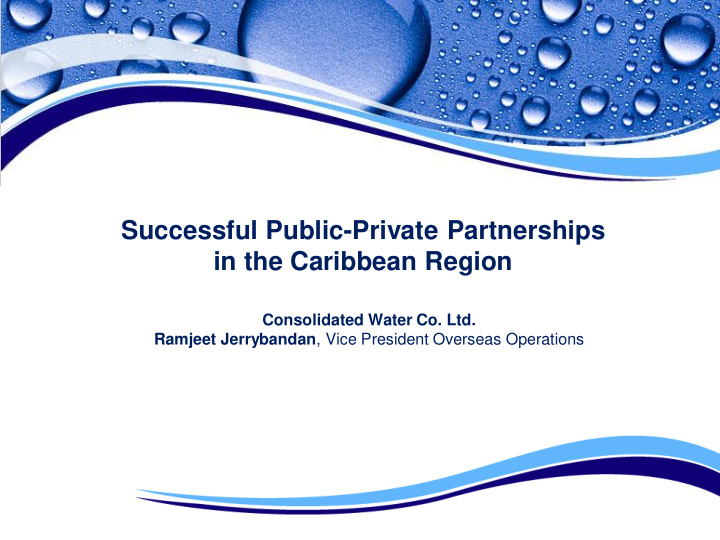



Successful Public-Private Partnerships in the Caribbean Region Consolidated Water Co. Ltd. Ramjeet Jerrybandan , Vice President Overseas Operations
Introduction Definition of PPPs “ A contractual agreement between a public agency and a private sector entity, where the skills and assets of both entities are shared in order to meet the common goal in delivering a service or facility for the use of the general public. The risks and rewards are also shared in the delivery ” US National Council for Public-Private Partnerships
PPP Models Some examples: • Design-Build (DB) • Design-Build-Maintain (DBM) • Design-Build-Operate-Maintain (DBOM) • Design-Build-Own-Operate-Transfer (DBOOT)
Water Industry q Hadera, Israel, 272,765 m 3 /d SWRO Plant (BOT) p Sydney, Australia, 250,000 m 3 /d SWRO Plant (DBO)
Water Industry Public sector’s strength: • Providing public infrastructural needs of the wider population Private sector’s strength: • New and creative ideas, technologies, and highly innovative solutions, which are especially important in sea water desalination
CASE STUDY I: Grand Cayman, Cayman Islands Retail Water Supply - Public Water Utility Concession • Distributor of potable water to about half the Island’s population through a license agreement with the Cayman Islands Government. Highlights: • Public sector focuses on being a water regulator • Private sector focuses on providing a safe and reliable supply of drinking water economically to the public
CASE STUDY II: Grand Cayman, Cayman Islands Bulk - DBOOT Contracts • 3 long-term DBOOT contracts with public sector, supplying a total of 5 million US gallons per day Highlights: • Public sector focuses on being a water distributor • Private sector focuses on providing a reliable bulk supply of drinking water utilising highly efficient technology
CASE STUDY III: New Providence, Bahamas Bulk - DBOO Contracts • 2 long-term DBOO contracts with public sector, supplying a total of 14 million US gallons per day Highlights: • Public sector focuses on being a water distributor • Private sector focuses on providing a reliable bulk supply of drinking water utilising highly efficient technology
PROs and CONs of PPPs PROS • Shared experience, expertise, resources and risk • Potential for decreased capital and operating costs based on high efficiency of private entity • Alternative financing options available rather than traditional debt financing • Minimised liability risk and improved health and safety CONS • Negative perception of lost ownership or control of national assets, public infrastructure or natural resources • For seawater desalination, issue relating to control of natural resource is not a factor
Risk Allocation Risks can be allocated between the sectors in three ways: PUBLIC PRIVATE PUBLIC PRIVATE Transferred Retained Risk PUBLIC PRIVATE Shared Risk No Risk Shared
Degree of Risk Privatisation Degree of Private Sector Risk Concession Design-Build-Finance-Maintain-Operate PPP Models Design-Build-Finance-Maintain Build-Finance Operation & Maintain Design-Build Degree of Private Sector Involvement Adapted from the Canadian Council for Public-Private Partnerships
Risks Unique to PPPs • Risks are related typically to long timeframes of projects. • Unique risk to the public sector - Long-term viability of the private entity • Unique risk to the private sector - Discontinuity of government policy across election cycles 10 years 20 years 15 years 25 years
Key Success Factors Statutory and political environment • Supporting legislative, political and regulatory conditions Due diligence • Reputable background and proven expertise Contractual terms • Value for money, defined roles and responsibilities, risk allocation, dispute resolution Economic viability • Potential for profit-making
Introduction Key to Success Modified Definition of PPPs “ A contractual agreement between a public agency and a private sector entity, where the skills and assets of both entities are allocated such that the skills and capabilities of each entity is maximised, in order to meet the common goal in delivering a service or facility for the use of the general public. The risks and rewards are also shared in the delivery according to its strength. ”
Recommend
More recommend